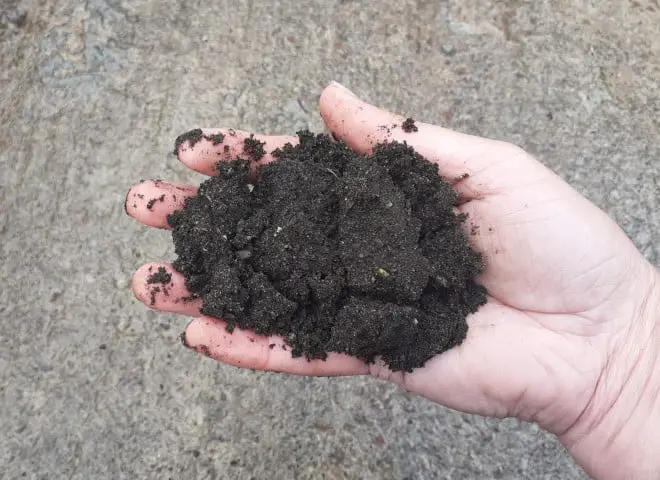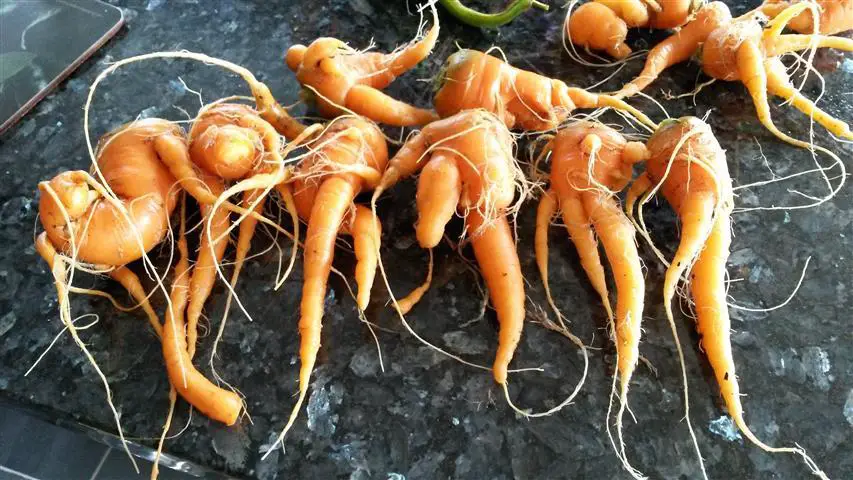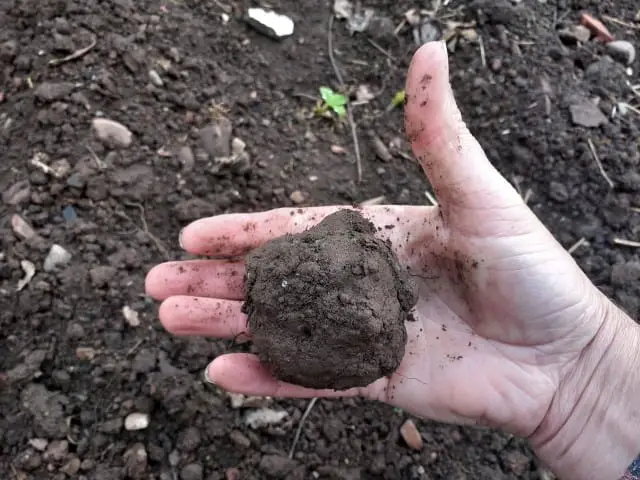I think it’s fair to say that not everyone has the ideal soil conditions for growing vegetables! The good news is that even if you have sandy soil with little in the way of nutrients, you can still grow amazing veggies with just a few simple steps.
Soil amendment is a process of adding other materials to soil in order to improve its qualities for growing purposes, and is something that most if not all gardeners have to do on a more-or-less constant basis.
However this should not be looked on as a chore – it is just part of the joy of gardening and reaping the benefits in terms of good healthy plants.
How do you know if you have sandy soil?
This is fairly easy. Just take a big handful of damp soil (wet it first if need be), and squeeze it tight in your fist, or make a ball with it.
If you open your hand and it all just falls apart without any cohesion evident, then you have sandy soil. There will also be evidence of grittiness when you rub your hands together with some of the soil present.
The soil falls apart because it does not retain enough moisture, organic matter, or sticky clay material to hold it all together.

This sandy/grainy texture is good for growing vegetables that require good drainage and free passage for their roots, but has little in the way of nutrient value as the sand or grit cannot hold onto the nutrients very well as the water flows through carrying the nutrients needed away from the plant.
How to fix sandy soil for growing veg
- Add organic matter such as compost or manure to the soil. This will give the nutrient value and help retain moisture as it slows down water loss.
- Add a few handfuls of vermiculite to the mix. This is good for both water and nutrient retention.
This is really all there is to it, the only real issue remaining is the volumes to add, and this is really determined by what vegetables you are growing and what condition your soil is in to start with.
As a rough rule of thumb though. I tend to add and mix the materials thoroughly all over the top 6 – 9 inches of the growing area (easier in a Raised Bed), and give it the ‘crush test’ by grasping a handful as described earlier.
The result I am looking for is that the material should keep a firm but not too compact sausage shape when I release my hand. This indicates that the material is able to hold water & nutrients, and is friable (crumbly) enough to allow for good root growth.
Vegetables that like sandy soil
Keep in mind that not all veggies hate sandy soil, in fact most veggies like it and there are a few that positively thrive in it – namely tap-root vegetables such as carrots and parsnips. Potatoes also do well in sandy soil but watering must be strictly adhered to as potatoes are water-hungry plants in general.
The reasons why carrots and parsnips do well in sandy soil is that they do not need too much in the way of nutrients, and prefer a free-draining growing medium. Too much nutrient value (particularly nitrogen) in the soil will lead to massive foliage – and small carrots or parsnips.
Another reason tap-root veggies love sandy soil is that deep root veggies do not like obstructions like stones or heavy clay in the soil. This can lead to split or misshapen carrots and is a common problem amongst carrot growers that plant in stony soil.

Other veggies that grow well in sandy soil include, peppers, tomatoes, lettuce, zucchini, and strawberries.
Veggies that do not like sandy soil.
Apart from the nutrient and water retention issue regarding sandy soil, there is the issue of support at the base of the plant and anchorage for the root systems.
This means that taller or larger plants tend to get blown around in the wind causing stress at the point where the stem leaves the ground surface.
Veggies that are prone to wind damage of this kind include brassicas such as cabbage, broccoli, brussels sprouts, kale, and any other tall plant such as corn that may well need supported.
Advantages of sandy soil for vegetable growing
- Sandy soil is free draining and not prone to standing water issues.
- Easy root penetration ideal for tap-root crops
- Light to work with making weeding a simple chore
- Root vegetables such as carrots, potatoes, beetroot all come out of the ground clean without sticky soil on them.
In fact it is for the reasons above that I almost always add an element of sand to my raised beds. Mixed with compost, vermiculite, and good topsoil, sand is a good addition to improve friability and drainage.
What kind of sand do you need? Builders washed sand will do just fine.
Growing vegetables in clay soil
Clay soil seems to get a lot of ‘bad press’ mainly because it is so sticky and messy, and often leads to pools of water around the vegetable yard.
However it is not all bad news, for clay soil also has some advantages over sandy or loamy soils.
Because the water retention is high in clay soils, provided there is enough organic matter present, plants such as cabbage, broccoli, brussels sprouts, and kale will all grow better because the heavy soil gives them firm anchorage and stops the damage caused by winds whipping them around.
To test if your soil has a high clay content, repeat the hand crush test above. If when you release your grip the soil in your hand retains a sausage shape without falling apart – then you have clay soil.
A further test is to take the wet soil and rub it between your fingers. Clay soil will be slippery and sticky to handle.
If you have a lot of clay in your soil you will also find that it is hard to break up during dry spells as the clay shrinks and forms a solid mass or clumps when digging.
Whilst a heavy clay soil may be just what you are looking for if you are growing rice in a paddy field, on its own it is not ideal for most vegetable gardeners!
The fix is like the sandy soil fix above, but this time you add sand into the mix as well as compost to help break down the clay and create a more breathable growing medium that will also drain well without waterlogging your veggie patch.
This simple addition means that your cabbages and broccoli will still have the root support they need, the nutrients/water will stick to the clay content and the roots can breathe through the compost mix.
It also makes the soil a lot easier to maintain and control weeds with simple hand tools rather than a pick and shovel!
Conclusion:
Whilst a loamy friable soil is the ideal for most gardeners, sandy soil on its own is not actually a bad thing – as long as it is mixed with a suitable amount of organic material to improve nutrition and growing conditions in general.
Most vegetables will actually thrive in sandy conditions if these conditions are met, whilst even cabbages and brassicas in general can be supported with garden fleece (which will also protect them from cabbage moth predation) or grown in more sheltered positions to protect from wind damage.
Overall, I personally would accept sandy conditions over heavy clay every time, it’s just easier to improve and once done, easier to maintain.



